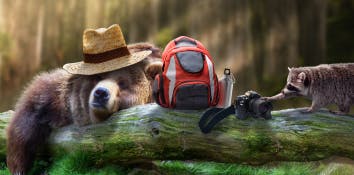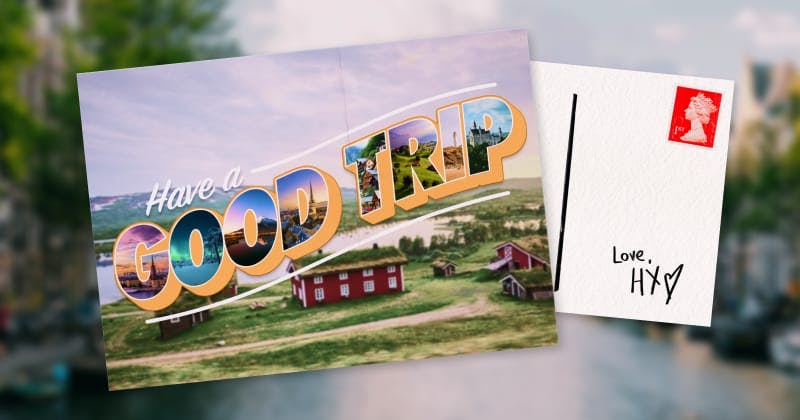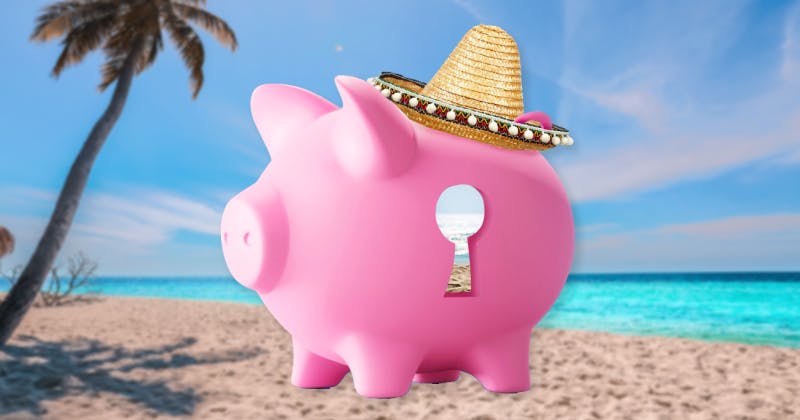
Norway Travel Guide
From lofty mountains to pristine fjords, modern cities to medieval settlements – here's everything you need to know about Norway.
What you'll find in this guide:
Top things to do in Norway
Facts about Norway
Practical Information
Weather in Norway
When to visit Norway
Getting to Norway
Getting around Norway
Where to stay in Norway
Accessibility in Norway
Norway for LGBTQI+ travellers
Sustainability in Norway
GMT +1
Norwegian krone NOK
Norwegian
Type C & F
2 Hours
Some facts about Norway
Like the UK, Norway is a constitutional monarchy – which means it has a head of state, King Harald V, and a head of government, Jonas Gahr Støere, the prime minister.
Unlike the UK, a large chunk of the country lies north of the Arctic Circle, with the wintry promise of dog-sledding, Northern Lights hunting and even polar bear spotting.
But if you don’t quite warm to that idea, what about the absolutely, jaw-droppingly beautiful fjords that characterise the country? Because of these fjords, the country has around 80,000km of coastline (or 50,000 miles) – that’s one of the longest coastlines in the world. Longer even than Australia, the USA and Russia. How bonkers is that?
Norway’s capital, Oslo, lies in the south of the country at the tip of its very own fjord. It’s got an intriguing mix of old-fashioned and modern scandi buildings, forested open spaces and galleries housing iconic pieces like Edvard Munch’s The Scream. Then there’s the fascinating maritime heritage of the city of Bergen, or the dramatic landscapes that surround Stavanger.
Practical Info
Culture and etiquette
Religion
70 to 80% of the population identify as Christian, with the main denomination being the Church of Norway.
Tipping
Do you need tip in Norway? About 5% is expected, but you can tip up to 15% if the service was particularly good.
Smoking
Smoking is illegal in enclosed public spaces, including shops, restaurants and public transport.
Language
The official language is Norwegian, though there are two variations: Bokmål and Nynorsk. Bokmål evolved from 14th-century Danish while Nynorsk, which means new Norwegian, was introduced in the 19th century and has Old Norse roots. Typically, Bokmål is spoken while Nynorsk is more often written. Either way, about 80% of the population also speak English.
Further north the indigenous language of the Sami is spoken, and this has official status as well.
Here are some Norwegian phrases to get you started:
Hello - Hallo
Excuse me - Unnskyld meg
Yes - Ja
No - Nei
Please - Vær så snill
Thank you - Takk
Do you speak English? - Snakker du Engelsk
How much does it cost? - Hvor mye koster det?
Where is? - Hvorer?
- One - En
- Two - To
- Three - Tre
- Four - Fire
- Five - Fem
- Six - Seks
- Seven - Syv
- Eight - Åtte
- Nine - Ni
- Ten - Ti
Goodbye - Ha det bra
Æ/æ pronounced like the ‘a’ in sad.
Ø/ø pronounced like the ‘ur’ in burn.
Å/å pronounced like the ‘o’ in lord.
Jabs, visas and other advice
Norway isn’t a member of the EU but it is in the Schengen Zone, making it essentially visa-free. That’s assuming you’re a UK citizen and staying for fewer than 90 days. You’ll need a return ticket and at least six months left on your passport though.
For up-to-date advice on jabs, visas and other foreign advice, we recommend following the government’s website
Emergency numbers
For fire call 110, police call 112 and call 113 if you need an ambulance.
What's the weather like in Norway?
Norway has four distinct seasons but of course it gets colder the further north you go – especially beyond the Arctic Circle where the sea around the remote island of Svalbard freezes solid.
The coastal southwest areas of the country have a temperate climate similar to the UK but with milder summers. Temperatures get a bit more extreme as you head closer to the mountains or the north, where snow or rain are a lot more common. Whatever time of year you visit, it’s always a good idea to prepare for rain.
When’s the best time to visit Norway?
The peak season is June to August when the weather is warmest and you can even enjoy a bit of midnight sun if you visit the right spot at the right time.
That’s not to say the country has nothing to offer throughout the rest of the year. It’s quietest in spring and autumn, but you can enjoy the colourful flowers that spring up around the edges of the fjords, or the crispy, golden foliage of the forests.
You could argue that Norway is at its best in winter, when snow covers more than just the mountain tops and you’ve got the best chance to see the Northern Lights.
Getting to Norway
It takes about two hours to fly from London to Oslo, which is ideal if you’re after a long weekend in the city with some time to explore the forests and mountains that surround it.
But one of the best and most popular ways to see the country is on a cruise ship. The fjords lend themselves perfectly to getting around this way, allowing you to take in the scenery in all its glory while stopping in some of the country's most iconic destinations, like Bergen, Tromsø and the island of Svalbard.
Or you can take the train. Oslo, Bergen and Trondheim are all part of the Interrail network, meaning you can get there from the UK using just one ticket.

Norway ranks 4th on the Good Trip Index
This score is calculated based on Sustainability, Human Rights, Women's Rights, Press Freedom, Quality of Life, LGBTQI+ Rights and Animal welfare
Find out moreGetting around Norway
You can drive around Norway quite comfortably using the well-maintained road network that connects all the big towns and cities by land. The roads snake up and down the mountains and along the shores of the fjords, making them one of the most scenic ways to explore.
You’ll probably spend a lot of time driving up and down slopes, so keep an eye on the temperature gauge and when going downhill drive in a lower gear so you don’t wear out the brakes. Also beware of elk jumping into the road.
There are more than 900 road tunnels in Norway as they’re the most efficient way of getting through the mountainous terrain. The Lærdal Tunnel is just under 25km long, making it the longest road tunnel in the world.
Most of Norway’s major cities, and those of its neighbours, are connected by an efficient rail network that passes stunning mountains, fjords and lakes. In fact, Lonely Planet named the Bergen Line one of Europe’s best train journeys.

Cruising in Norway
We’ve already mentioned how popular Norway is for cruises, thanks mostly to the iconic fjords that provide unlimited eyefulls of natural beauty. But given its relative proximity to the UK and year-round appeal, it’s the ideal entry-level destination for first-time cruisers.
The fjords themselves all usually have something unique to offer, whether it’s sleepy shoreside hamlets, tiny clifftop cottages, or spectacular landmarks like the Seven Sisters waterfall.
It’s also by far the easiest way to visit such remote locations as the North Cape and the island of Svalbard – absolute musts for adventurers looking for something a bit different. Trek over glaciers, explore the wilderness by snowmobile and go in search of polar bears.
Where to stay in Norway
Oslo
Quite separate from the dramatic scenery you might be expecting from the country, Oslo has an identity all its own. It’s a unique blend of traditional architecture, modern buildings and nature where you can enjoy traditional Norwegian cuisine, fascinating artwork and classic Scandi design.
The compact layout makes it easy to explore, whether you’re into the art of Munch Museum or the fascinating history of the Viking Ship Museum. Take a stroll along the Oslofjord waterfront or tour the Akershus Fortress which was once home to the royal family.

Bergen
Bergen has a rich maritime heritage thanks to its history as part of the Hanseatic League – a medieval alliance of merchants that thrived in northern Europe during the 12th century. UNESCO-protected storehouses that date from this period dominate the city’s waterfront, while lofty mountains encircle it by land.
The mountains are great for hiking but you can also ride to the top of Mount Fløyen aboard the Fløibanen – a funicular that offers stunning views of the city, mountains and sea that get better the higher you go. And once you’re up there you can explore the Troll Forest, a relaxing downhill trail with some cute fairytale carvings.

Tromsø
Tromsø is your gateway to Norway’s frosty north, and it’s also known as the Arctic Capital. At 70 degrees north it’s the largest city in northern Norway, stunning in winter when it’s illuminated from above by the Northern Lights, and in summer when the sun doesn’t dip below the horizon for two months.
Beyond the celestial spectacle, Tromsø boasts a vibrant cultural scene, with lively festivals, fascinating museums, and a rich history of Arctic exploration. Outdoor enthusiasts can indulge in thrilling activities like husky sledding, snowmobiling, and reindeer safaris – an unforgettable way to to see the dramatic, windswept tundra.

Longyearbyen
Take your adventuring to the next level when you visit Longyearbyen, the main settlement on Svalbard – a remote archipelago in the middle of the Arctic Ocean where polar bears roam free.
The town is set against a backdrop of open, untouched wilderness and rugged landscapes just begging to be explored. Aside from the natural wonders, Longyearbyen has a close-knit community and fascinating history, including coal mining heritage and research facilities. Head to the ghost town of Pyramiden, once a Soviet mining settlement, which was abandoned in 1998 when the coal ran out. Many of the buildings have been preserved, including the cinema, a hotel (which you can actually spend the night in!) and all the big old mining gear.
 Top
TopAccessibility in Norway
Norway is pretty well connected with an efficient public transport network, all of which is accessible for all travellers, from the railways to the ferries. Of course, the level of accessibility can vary depending on where you go – cobbled streets and hiking trails can be a bit trickier to navigate but with advance planning and the right assistance you shouldn't have any problems.
Take a look at Visit Norway’s accessibility page for more advice.
Norway for LGBTQI+ travellers
LGBTQI+ travellers are as welcome in Norway as everyone else. The laws there support equality, same-sex marriage has been legal since 2009 and public opinion is largely supportive of LGBTQI+ rights.
Oslo has a 10-day long pride every year where ideas of equality and human rights are explored through the mediums of art, debates and parties. You can usually find a gay bar in most big cities, Oslo and Bergen included, so if you’re after a night on the scene you won’t have to look far.
Sustainability in Norway
Norway is a world leader in sustainability and it landed in the top 3 for sustainability in our Good Trip Index. Around 98% of energy in Norway comes from renewable sources and the majority of that is hydropower.
Norway is also ahead of the game when it comes to electric cars, with a well-developed infrastructure making it super easy to switch to an electric vehicle (or hire one!) – of course this all results in cleaner air and fewer emissions.
To keep the country’s incredible landscapes preserved for years to come, a significant portion of the country is dedicated as national parks or protected habitats.
It’s worth mentioning that while Norway is now a world leader in sustainability, it’s a relatively big exporter of oil. So while it doesn’t use a lot of it, a chunk of its economy does rely on the drilling and sale of oil and gas.
Top

























